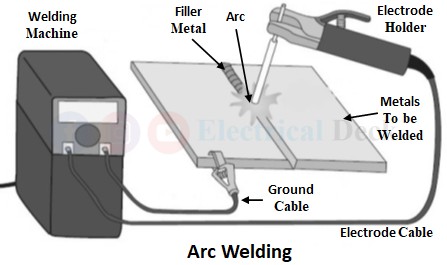Generally, there are two types of electric welding techniques by which two metals can be welded (joined). They are resistance welding and arc welding. In this article let us learn about the difference between resistance welding and arc welding.
Resistance Welding :
Resistance welding is a type of electric welding in which a sufficiently high current at the lowest voltage is passed through the joint where two metals are to be welded. Due to the resistance offered by the two metals to the flow of high current, the temperature at the joint area increases and melts the two metal pieces at the joint area.
The current used in resistance welding is more than 100A and a voltage value ranging from 4 to 12V is used depending upon the composition, area, and thickness of the metal pieces to be welded. This high current develops heat in the joint area due to the resistance offered by the metals to the flow of the current. The heat developed at the area to be welded reduces the metal to a plastic or liquid state, then after the two metal pieces are pressed together to complete the weld as shown below.
The current to the two metal pieces is given through two electrodes of low resistance and pressure at the weld area is applied through two electrodes. Since it is easy to obtain the required combinations of voltage and current values through an ac supply using a transformer, an ac power supply is most preferable for the resistance welding process. The heat developed in resistance welding is expressed as I2R t, where 't' is the current flow time.
Arc Welding :
Arc welding is another type of electric welding and it is the most widely used welding method. In this method, the two metal pieces to be welded will be heated by creating an electric arc. The two metal pieces are brought to the welding temperature at the point of joint by producing an electric arc struck between electrode and metal piece to be welded connected to the suitable supply source as shown below.
The heat is liberated at the joint area of two pieces making its fusion and melting the part of the workpiece. Filler metal is added to fill the joint area of two pieces and to complete the joint, thus forming the weld. Hence in electric arc welding, the two metal pieces are welded by localized heat without any pressure thereby calling it non-pressure welding.
The different types of arc welding are, carbon arc welding (where the electrode used is made up of carbon), metal arc welding (where the electrode used is made up of metal), hydrogen arc welding, etc. Arc welding can be done by using either ac or dc power supply.
Comparison Between Resistance Welding and Arc Welding :
| Resistance Welding | Arc Welding |
|---|---|
| AC supply is mostly used for resistance welding. | Both ac, as well as dc supply, is used in arc welding. |
| No additional material is required to get the metal pieces joined. | A filler material is used to perfect strength in the metal. |
| Resistance welding requires low voltage with high currents. | An arc requires more voltage to strike than to be maintained. |
| In this type of welding, external pressure is applied. | Here no external pressure is required, thus the material can be welded very easily. |
| The heat produced is mainly due to the contact resistance. | The heat produced is due to the arc formed in between the electrode and the metal piece to be welded. |
| The temperature is less when compared to the arc welding temperature. | The arc produced will have a very high temperature and may cause damage. |
| The power factor of resistance welding will be 0.25 or 0.3 lagging. | The power factor of arc welding is very poor. |
| It is advantageous for mass production. | It is advantageous for repair work. |
| It is not used for repair work. | It is not used for mass production. |
| The electrodes used in resistance welding are roller, flat, or bar-type electrodes. | The electrodes used in arc welding are flux-coated metal electrodes. |
| Power consumption is low in resistance welding. | Arc welding consumes more power. |


